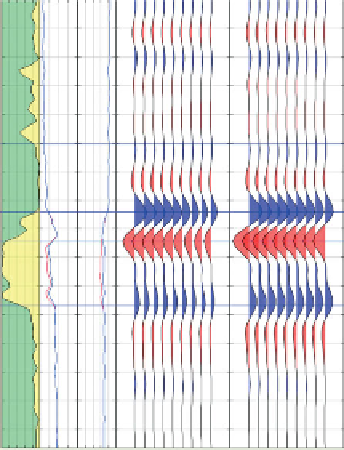Geology Reference
In-Depth Information
a)
b)
Synthetic: silt above sand
Synthetic: no silt above sand
Lith
AI PR
Water
(0-40º)
Oil
(0-40º)
Lith
AI PR
Water
(0-40º)
Oil
(0-40º)
c)
d)
AVO Crossplot: silt above sand
AVO Crossplot: no silt above sand
0.3
0.3
Silt case - oil
Silt case - wet
No silt case - oil
No silt case - wet
0.2
0.2
35º
10º
0.1
0.1
0
0
-0.1
-0.1
-0.2
-0.2
-0.3
-0.3
-0.3
-0.2
-0.1
0
0.1
0.2
0.3
-0.3
-0.2
-0.1
0
0.1
0.2
0.3
Intercept
Intercept
Figure 7.10
A model example of a top sand AVO signature that varies due to the presence or absence of a high impedance silt unit
above sand; (a) synthetic with silt above sand, (b) synthetic with silt removed, (c) top sand AVO crossplot of data in (a), (d) top sand AVO
crossplot of data in (b).
7.2.6 Multi-layered reservoirs
There are some thick reservoir sequences in which the
differential AVO effects are very limited but owing to
the multi-layered contrasts a general brightening of
the section is a good hydrocarbon indicator.
Figure
7.18
shows an example of a deltaic sequence of fairly
low porosity, thin-bedded sands and shales with lat-
eral thickness variations. It is difficult to reliably
interpret hydrocarbon effects from brightening or
dimming at the top sequence reflection as has been
described in the previous AVO scenarios, mainly
because
134
it
is
an unconformity with variable




















































































































































